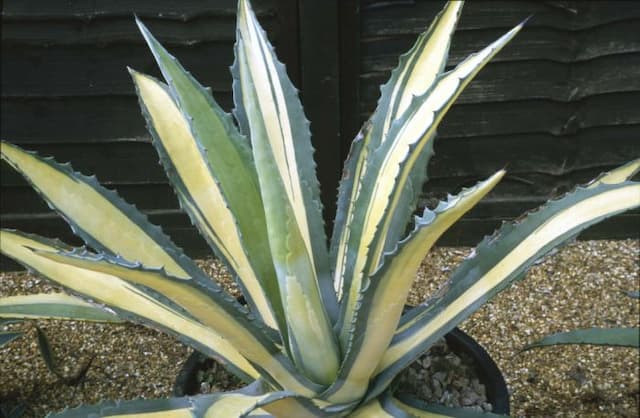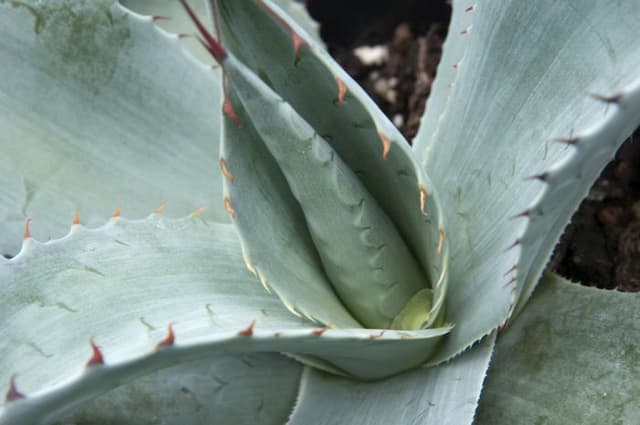Mexican Lily Beschorneria yuccoides

ABOUT
The plant commonly known as Mexican Lily has a striking appearance with its rosette of long, narrow leaves which resemble those of yucca plants, giving it a very architectural look. The leaves are typically a blue-green color and can have a leathery texture, providing a year-round display of foliage that adds structure to garden spaces. Despite the yucca-like appearance, it is actually softer and does not have the sharp spines found on true yucca plant tips. The leaves arch gracefully and emerge from a central point, creating a starburst pattern. Mexican Lily becomes particularly eye-catching when it blooms, producing impressive flower spikes. The flowers emerge high above the foliage on tall stems and are tubular shaped, typically seen in colors ranging from green to red. These flowering spikes are adorned with numerous small flowers that are favored by hummingbirds and other pollinators. After the flowering period, the plant may produce attractive seed capsules. Overall, the Mexican Lily offers a dramatic visual element to landscapes with its spiky foliage and showy blooms, but it is also appreciated for its low maintenance and drought tolerance. It is well-loved by gardeners looking to add a touch of the exotic or to create a focal point in their planting schemes.
About this plant
 Names
NamesFamily
Asparagaceae
Synonyms
Mexican Lily, False Red Agave, Amole De Bolsa
Common names
Beschorneria yuccoides
 Toxicity
ToxicityTo humans
Beschorneria yuccoides, commonly known as Mexican Lily, is not widely regarded as a poisonous plant. There is a lack of documentation or significant evidence indicating that this plant poses serious risks upon ingestion by humans. However, as with many plants, sensitive individuals may experience mild irritation or an allergic reaction if they come into contact with the sap or ingest parts of the Mexican Lily. If symptoms do appear, they may include gastrointestinal discomfort such as nausea, vomiting, or diarrhea. It's always prudent to keep an eye out for unexpected reactions and to seek medical attention if any adverse effects occur after handling or ingesting any part of the plant.
To pets
Mexican Lily is not commonly listed as a toxic plant for pets. There is no significant evidence to suggest that Beschorneria yuccoides poses a severe risk to dogs, cats, or other household pets upon ingestion. Nonetheless, as some pets may experience sensitivities or allergies to plants that are not typically regarded as toxic, mild gastrointestinal upset—such as vomiting or diarrhea—could occur if a pet ingests parts of the Mexican Lily. Pet owners should monitor their animals for signs of distress and consult with a veterinarian if their pet exhibits any adverse symptoms after contact with the plant.
 Characteristics
CharacteristicsLife cycle
Perennials
Foliage type
Evergreen
Color of leaves
Green
Flower color
Greenish
Height
2-4 feet (0.6-1.2 meters)
Spread
2-3 feet (0.6-0.9 meters)
Plant type
Succulent
Hardiness zones
8
Native area
Mexico
Benefits
 General Benefits
General Benefits- Drought Tolerance: Beschorneria yuccoides, commonly known as Mexican lily, requires minimal watering, making it suitable for drought-prone areas and water-wise gardens.
- Low Maintenance: This plant demands little care once established, needing only occasional trimming of spent flower stalks and dead leaves.
- Landscape Design: With its rosettes of long, leathery leaves, the Mexican lily provides an architectural element to garden designs, serving as a focal point or an accent in mixed borders.
- Attracts Wildlife: The tall flower spikes of the Mexican lily can attract hummingbirds and other pollinators to the garden, promoting biodiversity.
- Year Round Interest: Even when not in bloom, the Mexican lily offers year-round interest with its evergreen foliage.
- Erosion Control: The root system of the Mexican lily helps stabilize soil and can help in controlling erosion on slopes.
- Adaptability: It can adapt to a variety of soil types, although it prefers well-draining soil, which makes it versatile for different garden settings.
- Cold Tolerance: While it thrives in warm climates, the Mexican lily can also tolerate frosts and brief cold snaps in certain climates.
 Medical Properties
Medical PropertiesThis plant is not used for medical purposes.
 Air-purifying Qualities
Air-purifying QualitiesThis plant is not specifically known for air purifying qualities.
 Other Uses
Other Uses- Beschorneria yuccoides, commonly known as the Mexican Lily, can be used in sustainable landscaping as it requires minimal watering and maintenance once established, contributing to water conservation efforts.
- Due to its dramatic flower spikes, the Mexican Lily is often used as a focal point in ornamental gardens, providing a unique visual interest.
- The fibers from the leaves of the Mexican Lily can be used for making cords and ropes in local crafts, drawing on the traditional uses of agave and related species for fiber.
- By planting the Mexican Lily in urban areas, cities can improve the overall aesthetic of public spaces with its striking architectural form.
- The flowers of the Mexican Lily can attract hummingbirds and other pollinators, making it a beneficial plant for supporting local wildlife and biodiversity.
- Used in xeriscaping, the Mexican Lily contributes to landscapes that reduce or eliminate the need for supplemental water from irrigation, important in regions experiencing drought.
- As an educational tool in botanic gardens and conservation areas, the Mexican Lily can be used to teach about arid and semi-arid ecosystems, their plants, and adaptations.
- Commercially, the Mexican Lily is cultivated for sale as an exotic plant in the nursery industry, appealing to enthusiasts of drought-resistant and desert plants.
- In large containers, the Mexican Lily can be grown as a patio plant to enhance outdoor living spaces with its striking foliage and inflorescence.
- The structural appearance of the Mexican Lily makes it suitable for contemporary garden designs that emphasize form and texture over color variance.
Interesting Facts
 Feng Shui
Feng ShuiThe Mexican lily is not used in Feng Shui practice.
 Zodiac Sign Compitability
Zodiac Sign CompitabilityThe Mexican lily is not used in astrology practice.
 Plant Symbolism
Plant Symbolism- Adaptability: Beschorneria yuccoides, commonly known as Mexican Lily, is from a genus that is native to semi-arid climates, suggesting a symbolism of adaptability and thriving in challenging conditions.
- Resilience: The Mexican Lily's ability to store water and resist drought represents resilience and the ability to withstand hardships.
- Survival: With its efficient use of resources, the Mexican Lily epitomizes survival and durability in tough environments.
- Beauty in Simplicity: Known for its simple yet striking appearance, the Mexican Lily symbolizes the concept of finding beauty in simplicity and minimalism.
- Unique Charm: As the Mexican Lily is not as common as other ornamental plants, it can symbolize unique charm and standing out from the crowd.
 Water
WaterThe Mexican Lily needs to be watered when the top inch of soil feels dry to the touch. In general, this might mean watering approximately once a week, but this can vary based on the humidity and temperature of its environment. Before watering, check the soil moisture to prevent overwatering. Provide a thorough soaking until water runs out of the drainage holes, using about a half gallon for a medium-sized pot. During the dormant winter period, reduce the frequency of watering to every other week or less.
 Light
LightThe Mexican Lily thrives best in bright, indirect light conditions. It can tolerate some direct morning sun but should be shielded from intense afternoon sunlight to avoid leaf burn. A spot near an east-facing window or a few feet away from a south or west-facing window would be ideal.
 Temperature
TemperatureThe Mexican Lily prefers temperatures between 50 and 90 degrees Fahrenheit but can survive in temperatures as low as 40 degrees. Ideal growing conditions are within 60 to 80 degrees Fahrenheit. Ensure the plant is protected from frost and cold drafts, as well as extreme heat.
 Pruning
PruningThe Mexican Lily requires minimal pruning, mainly to remove old flower stalks or damaged leaves to maintain its appearance and encourage new growth. Prune after it finishes flowering, typically at the end of summer or early fall. This is the best time for pruning to prepare the plant for its next growth cycle.
 Cleaning
CleaningAs needed
 Soil
SoilMexican Lily requires a well-draining soil mix to prevent root rot. A good blend is 2 parts loam, 1 part perlite or coarse sand, and 1 part peat. This plant prefers a slightly acidic to neutral pH, ideally between 6.0 and 7.0.
 Repotting
RepottingMexican Lily should be repotted every 2 to 3 years or when it becomes root-bound. Choose a pot that is one size larger, and repot in the spring or early summer for best results.
 Humidity & Misting
Humidity & MistingMexican Lily thrives in moderate to high humidity levels, preferring around 40-50%. Avoid placing it in excessively dry environments, which might necessitate the use of a humidifier or regular misting.
 Suitable locations
Suitable locationsIndoor
Place Mexican Lily in bright, indirect light and water moderately.
Outdoor
Mexican Lily needs partial sun and shelter from harsh weather.
Hardiness zone
9-11 USDA
 Life cycle
Life cycleThe life of Beschorneria yuccoides, commonly known as Mexican Lily, begins with seed germination, where the seeds require well-drained soil and warmth to sprout roots and shoots. After germination, the seedling stage follows, characterized by the growth of a rosette of narrow, leathery, evergreen leaves that are characteristic of the plant. As the Mexican Lily matures, it forms a thick, fleshy stem that stores water, allowing the plant to survive in dry conditions. It may take several years before it reaches the flowering stage, where it produces tall, dramatic flower spikes with tubular red or green flowers that attract hummingbirds and other pollinators. After pollination, the plant sets seed, which can be dispersed by wind or wildlife, perpetuating the cycle. As a perennial, it can live for many years, but after flowering, individual rosettes often die, to be replaced by new growth from the base or from offshoots.
 Propogation
PropogationPropogation time
Spring to summer
The most popular method of propagation for the Mexican Lily, or Beschorneria yuccoides, is by removing and planting the offsets, which are small plants that grow at the base of the parent plant. This is typically done in the spring or early summer when the plant is actively growing. To propagate, carefully dig around the base of the plant to expose the offsets, and then gently separate them from the mother plant, making sure to retain as many roots as possible. These offsets can then be planted in well-draining soil, placed in a location with indirect light, and watered sparingly until they establish a strong root system. After a few weeks, when the offsets show signs of new growth, watering can be increased gradually. This method leverages the plant's natural tendency to produce clones of itself, ensuring a high success rate and a new plant that is identical to the parent.


![Beschorneria [Flamingo Glow]](/_next/image?url=https%3A%2F%2Fplants-admin.emdemapps.com%2Fimages%2Fplants%2F%2Fimages%2F604b59df2e78d.png&w=640&q=75)





